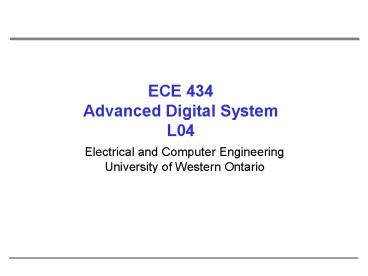ECE 434 Advanced Digital System L04 - PowerPoint PPT Presentation
1 / 27
Title:
ECE 434 Advanced Digital System L04
Description:
University of Western Ontario. 11/2/09. UAH-CPE/EE 422/522. AM 2. Outline. What we know ... n inputs and m outputs m functions of n variables ... – PowerPoint PPT presentation
Number of Views:51
Avg rating:3.0/5.0
Title: ECE 434 Advanced Digital System L04
1
ECE 434Advanced Digital SystemL04
- Electrical and Computer EngineeringUniversity of
Western Ontario
2
Outline
- What we know
- Combinational Networks
- Analysis
- Synthesis
- AND-OR-NOTs, NORs, NANDs, MUXes, ROMs, PLAs
- Hazards in combinational networks
- What we do not know
- PALs
- Sequential Networks
- Basic Building Blocks
- Mealy Sequential Networks
3
Review Basic ROM Structure
- ROM Types
- Mask-programmable ROM
- EPROM
- EEPROM
- Flash
4
Review Programmable Logic Arrays
- Perform the same function as a ROM
- n inputs and m outputs m functions of n
variables - AND array realizes product terms of the input
variables - OR array ORs together the product terms
5
Review PLA with 3 inputs, 5 p.t., 4 outputs
6
Programmable Array Logic (PALs)
- PLAs
- Both AND and OR arrays are programmable
- PAL is a special case of PLA
- AND array is programmable and OR array is fixed
- Motivation for PALs
- Programmable switches historically presented two
difficulties to the manufacturers - hard to fabricate correctly gt increase the price
- reduce the speed performance of circuits
- PALs are less expensive, faster, and easier to
program - Disadvantage less flexible
7
Programmable Array Logic (PALs)
Unprogrammed
Programmed
8
Using PALs An Example
x
x
x
1
2
3
Implement the following
P
1
P
2
P
3
P
4
AND plane
9
Using PALs An Example
x
x
x
1
2
3
P
1
f
1
P
2
P
3
f
2
P
4
AND plane
10
Typical PALs
- Typical PALs have
- from 10 to 20 inputs
- from 2 to 10 outputs
- from 2 to 8 AND gates driving each OR gate
- often include D flip-flops
MUX output is fed back to the AND plane. Why?
11
Logic Diagram for 16R4 PAL
12
Logic Diagram for 16R4 PAL
13
Sequential Networks
- Have memory (state)
- Present state depends not only on the current
input, but also on all previous inputs (history) - Future state depends on the current input and
state
X x1 x2... xn
Q Q1 Q2... Qk
Z z1 z2... zm
x1
z1
x2
z2
Q
Flip-flops are commonly used as storage
devicesD-FF, JK-FF, T-FF
xn
zm
14
Clocked D Flip-Flop with Rising-edge Trigger
Next state
The next state in response to the rising edge of
the clock is equal to the D input before the
rising edge
15
Clocked JK Flip-Flop
Next state
JK 00 gt no state change occurs JK 10 gt the
flip-flop is set to 1, independent of the current
state JK 01 gt the flip-flop is always reset to
0 JK 11 gt the flip-flop changes the state Q
Q
16
Clocked JK Flip-Flop
Next state
T 1 gt the flip-flop changes the state Q
Q T 0 gt no state change
17
S-R Latch
18
Transparent D Latch
19
Transparent D Latch
20
Mealy Sequential Networks
General model of Mealy Sequential Network
- (1) X inputs are changed to a new value
- After a delay, the Z outputs and next state
appear at the output of CM - (3) The next state is clocked into the state
register and the state changes
21
An Example 8421 BCD to Excess3 BCD Code Converter
22
State Graph and Table for Code Converter
23
State Assignment Rules
24
Transition Table
25
K-maps
26
Realization
27
To Do
- Study textbook chapters
- 3.1, 3.2, 3.3, 1.6, 1.7
- Do homework 1































